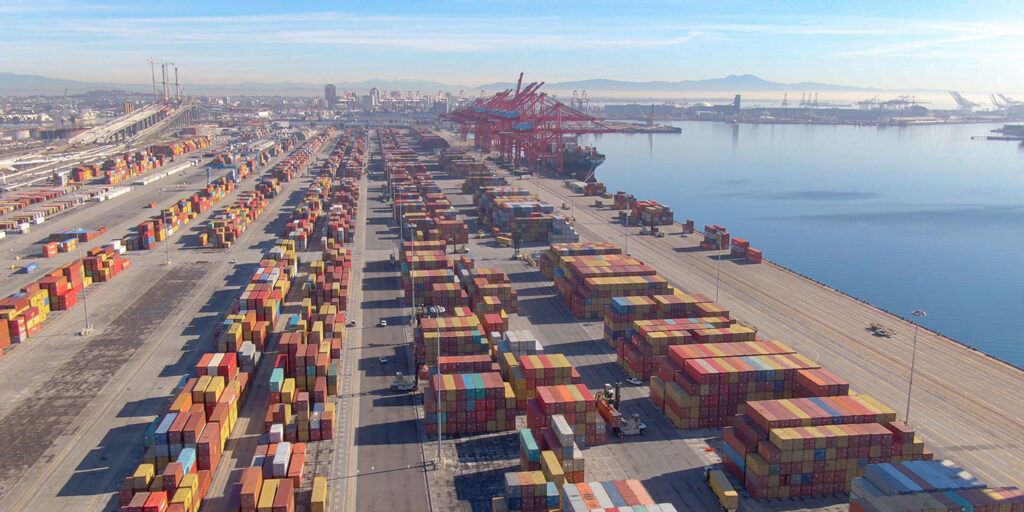At Heavy Duty Aftermarket Week, Mark Hazel, associate director, commercial vehicle reporting, IHS Markit, moderated a virtual conversation with Gene Seroka, executive director, and Tom Gazsi, deputy director and Chief of police, for the Port of Los Angeles. The port has been a lightning rod in the supply chain challenges as containers continue to pile up. Seroka noted that it’s a ripple effect from when the world shut down just under two years ago and then demand for goods came roaring back.
“We saw our business shoot up 50% in the third quarter of 2020 compared to what we had witnessed in the first two quarters–just an unbelievable surge,” Seroka said. “Our longshore men and women have been on the ground working on average six days a week since the pandemic began. We’ve got folks going all out, trying to manage this huge flow of cargo that we see.”
Here are a few more quotables from the panel.
‘We’ve never moved more cargo than we have in the past 18 months.’
Seroka stated that the Port of L.A. set the all time record for a Western hemisphere port over a 12 month cycle with 10.8 million container units.
“We finished up the year strong,” he said before acknowledging some headwinds. “Costs have changed quite a bit–whether it’s how much importers pay for ocean freight on those containers to warehouse space, trucking services, et cetera. The port has long term contracts with its customers and tenants. Those agreements typically are 20 to 30 years in duration. We don’t see huge swings in our own revenue, but at cargo volume that we’ve seen come in, it creates more opportunities for jobs. Everyone who wants to work right now has a role to play at the port.”
Jobs, however, equals increase costs for the port.
“The cargo that traverses our port complex reaches each and every one of our nation’s 435 congressional districts,” he continued. “One in nine jobs regionally in Southern California are dedicated to this port complex–truck drivers, warehouse folks, importers, exporters, logisticians, and administrators like myself alike. That’s one million paychecks a week that go into this local economy because of port complex. Everything we do affects someone. We need to keep segmenting cargo to make sure we have an understanding of what needs to get to market. That was the challenge we faced beginning last summer.”
What’s ahead for the port in 2022
“Consumer buy behavior seems to be strong,” Seroka said. “Cargo coming in right now is ahead of an early lunar new year. You’ll see a second quarter where many of the retailers try to focus on inventory replenishment, and then hopefully we’ll be able to pivot into a more normalized peak season year at the mid- to late summer.
“My recommendation is that we isolate the cargo that has got to get to the factory level as well as to the distributor levels best we can,” Seroka said. “That’s why we created the first, and still only, port community system here in the United States. The port optimizer gives us the ability to front load information. So we know how to prepare staffing and equipment to move cargo more succinctly and bring certainty back to the supply chain.
“Happy to work offline with leadership to see what we can do to bring this group into our data sharing platform,” he concluded.
Speaking of technology, data security is paramount in the port’s operations
In 2014, the Port of L.A. established the Cyber Security Operation Center, and for good reason.
“Since 2014 to pre-COVID times, we were experiencing between 12 million and 20 million intrusion attempts a month at the Port of Los Angeles,” Gazsi said. “It was Gene’s idea that if we could expand that program throughout the port complex, to our tenants, clients, customers in steamship lines, trucking, rail, and so forth, then we could better protect and have an early detection of cyber threats in the entire port complex. What was born is what we refer to as the Cyber Resilient Center.”
It’s an early detection system with approximately 44 individual companies participating. It allows the port to detect, identify, mitigate, and assist in the recovery of cyber attacks to help keep cargo flowing freely.
“Part of our message is: Regardless of our place in this industry, we need to ensure that our cyber systems are robust. That we’re using reputable companies that are providing cyber security, as well as having corporate and business cyber systems that have early detection to keep your systems up to date and operating efficiently.”














